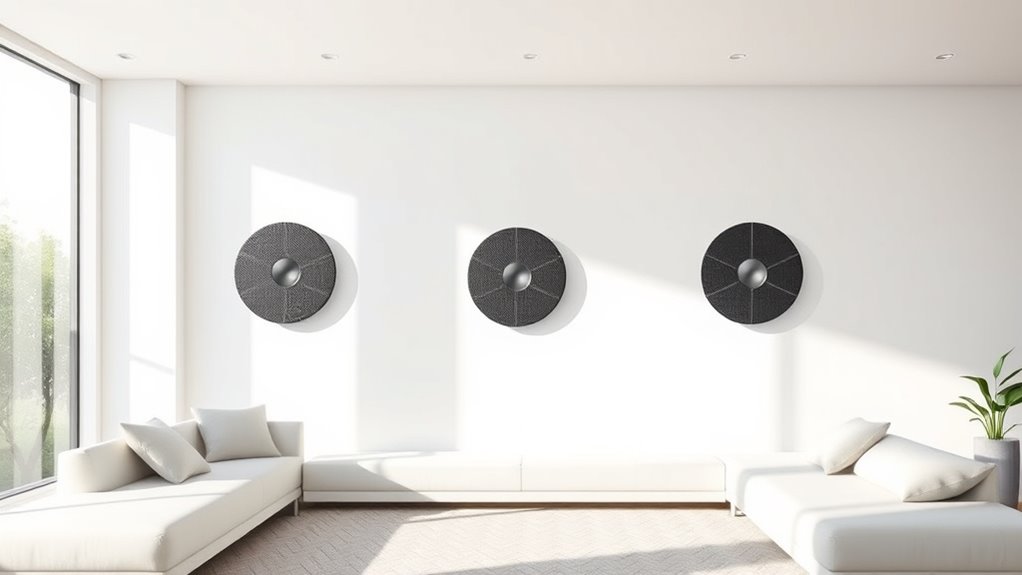If you’re looking for the best mesh Wi-Fi systems in 2025, I’ve tested top options like the TP-Link Deco XE75, Amazon eero 6+, and Google Nest WiFi Pro to guarantee seamless coverage and quick speeds for homes of all sizes. These systems support dozens of devices, include smart home features, and offer easy setup, making them ideal choices. Stay tuned to discover details about each system and find the perfect fit for your home.
Key Takeaways
- Consider coverage area, device support, and home layout to choose the right mesh system for seamless connectivity.
- Prioritize Wi-Fi 6E and Wi-Fi 7 models for faster speeds and future-proof performance.
- Look for systems with easy setup, management apps, and compatibility with smart home devices.
- Evaluate wired versus wireless backhaul options for optimal stability and low latency.
- Balance features like security, smart home integration, and cost to select the best mesh Wi-Fi system for 2025.
TP-Link Deco XE75 AXE5400 Tri-Band WiFi 6E Mesh System
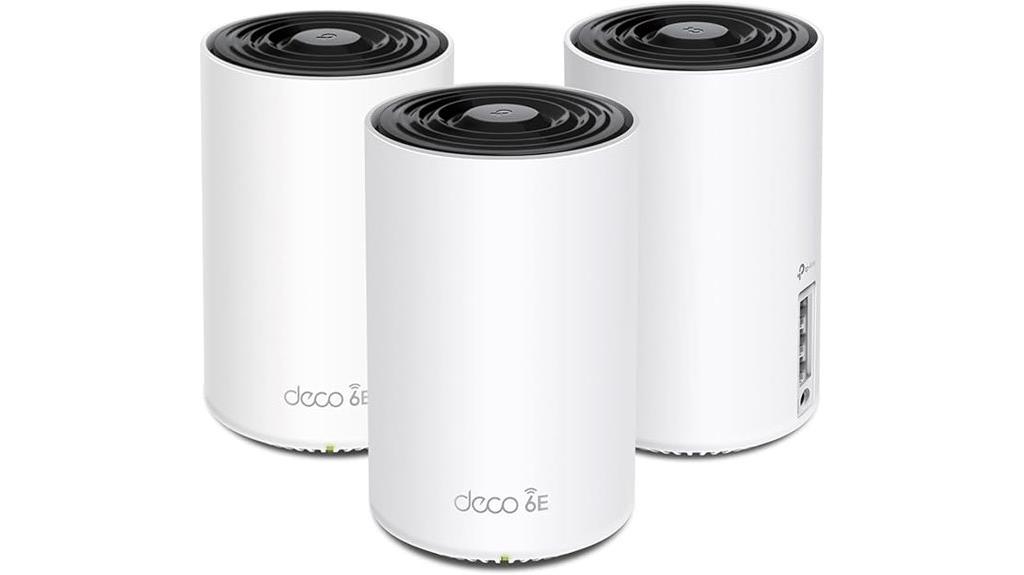
The TP-Link Deco XE75 AXE5400 Tri-Band WiFi 6E Mesh System is an excellent choice for anyone seeking reliable, high-speed internet coverage across a large home or office—thanks to its ability to cover up to 7,200 square feet and support up to 200 devices. It replaces traditional routers and extenders, offering seamless coverage with AI-driven mesh technology. Supporting WiFi 6E on the new 6 GHz band, it reduces interference and improves stability. With tri-band speeds up to 5,400 Mbps, easy setup via the Deco app, and compatibility with smart devices, it’s ideal for busy households and small offices. Security features and support make it a versatile, future-proof solution.
Best For: households and small offices seeking reliable, high-speed WiFi coverage across large areas with easy setup and advanced security.
Pros:
- Covers up to 7,200 sq.ft and supports up to 200 devices for extensive, stable connectivity
- Supports WiFi 6E with a dedicated 6 GHz band for less interference and improved performance
- Easy to set up and manage via the Deco app with seamless mesh technology
Cons:
- Requires a modem for most internet service providers, adding to initial setup complexity
- Some users may need to disable 6 GHz for better range or device compatibility
- The price point around $219 may be higher than basic routers for budget-conscious users
TP-Link Deco AX3000 WiFi 6 Mesh System (Deco X55)
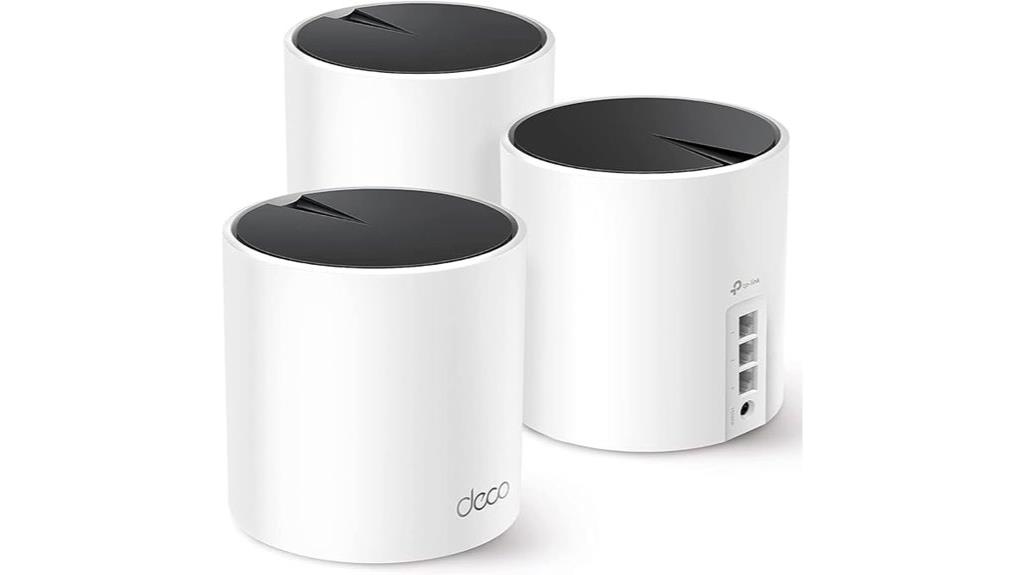
If you have a large home and need seamless WiFi coverage that eliminates dead zones, the TP-Link Deco AX3000 WiFi 6 Mesh System (Deco X55) is an excellent choice. Covering up to 6,500 square feet, it replaces traditional routers and extenders, supporting Ethernet backhaul and up to 150 devices. With faster WiFi speeds (AX3000) ideal for gigabit plans, it offers reliable, wide-reaching signals—even at long distances. Easy to set up via the Deco app and managed remotely, it combines strong performance, security, and scalability, making it perfect for busy households demanding stable, high-speed connectivity everywhere.
Best For: households with large or multi-story homes seeking reliable, high-speed WiFi coverage that eliminates dead zones and supports many devices.
Pros:
- Covers up to 6,500 sq.ft. with seamless mesh coverage, ideal for large homes
- Supports WiFi 6 (AX3000) for faster speeds and better device capacity
- Easy setup and management via the Deco app, with remote control options
Cons:
- Occasional connectivity issues may require troubleshooting or restart
- Setup can be challenging if placement guidelines are not followed properly
- Slightly higher price point compared to traditional routers or extenders
Amazon eero 6+ Mesh WiFi System (3-Pack)
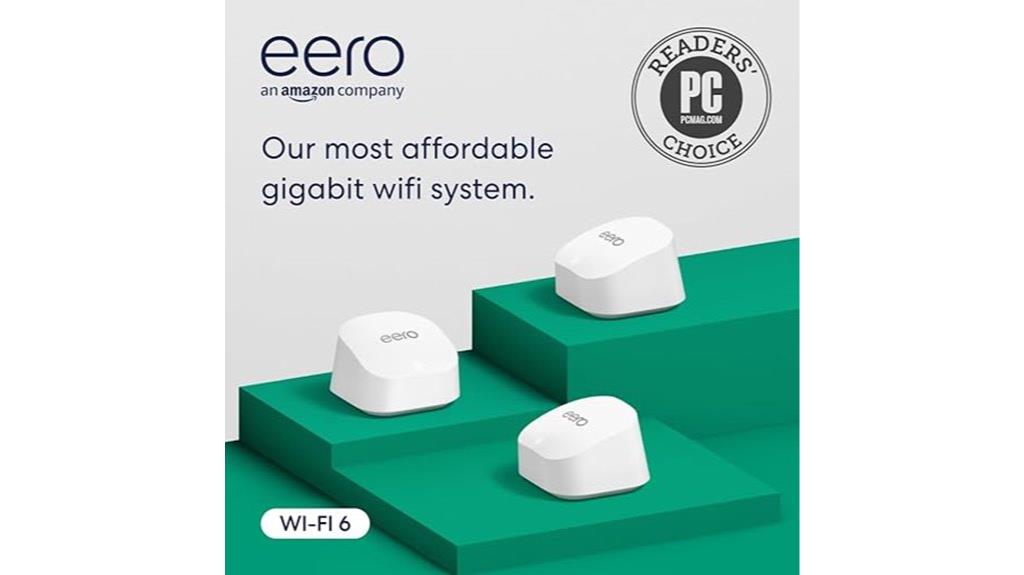
Designed for large homes and busy households, the Amazon eero 6+ Mesh WiFi System (3-Pack) delivers gigabit speeds and seamless coverage up to 4,500 square feet. It supports over 75 devices simultaneously, thanks to Wi-Fi 6 dual-band technology, ensuring fast, reliable connections for streaming, work, and smart home devices. The system includes two gigabit Ethernet ports, a built-in smart home hub compatible with Zigbee, Thread, Alexa, and Bluetooth Low Energy, plus robust security features like WPA3. Setup is straightforward via the eero app, and the mesh network intelligently routes traffic to eliminate dead spots, making it an excellent choice for large, connected homes.
Best For: households with large, multi-room homes needing reliable, high-speed Wi-Fi and smart home integration support.
Pros:
- Supports gigabit speeds up to 1 Gbps with Wi-Fi 6 for fast, simultaneous connections
- Covers up to 4,500 sq ft, ideal for large homes and busy households
- Built-in smart home hub compatible with Zigbee, Thread, Alexa, and Bluetooth Low Energy
Cons:
- Slightly bulky design may be less aesthetically pleasing in some spaces
- Initial setup can require troubleshooting for placement and interference issues
- Subscription required for advanced network management features
TP-Link Deco BE23 Dual-Band WiFi 7 Mesh System (3-Pack)

For anyone seeking a future-proof Wi-Fi solution that can handle multiple devices and high-bandwidth activities, the TP-Link Deco BE23 Dual-Band WiFi 7 Mesh System stands out. It offers impressive speeds up to 3.6 Gbps, supporting over 150 devices across a coverage area of 6,500 sq. ft. with three units. Equipped with Wi-Fi 7 features like Multi-Link Operation, OFDMA, and smart connect, it ensures fast, reliable streaming, gaming, and browsing. The system includes wired backhaul ports, advanced security, and compatibility with smart home devices. Easy to set up via the Deco app, it’s ideal for large homes and tech-savvy users looking for seamless, high-performance connectivity.
Best For: tech-savvy homeowners and large households seeking a high-speed, reliable, future-proof Wi-Fi 7 mesh system with extensive coverage and device support.
Pros:
- Supports ultra-fast speeds up to 3.6 Gbps and over 150 devices simultaneously.
- Features advanced Wi-Fi 7 technologies like Multi-Link Operation, OFDMA, and smart connect for seamless performance.
- Easy setup and management via the Deco app, with comprehensive security features and wired backhaul options.
Cons:
- Some users report QoS issues causing latency spikes during gaming sessions.
- Slightly larger unit size may be less discreet in certain home setups.
- Requires firmware updates to resolve minor bugs and optimize features over time.
TP-Link Deco S4 Mesh AC1900 WiFi System (3-Pack)
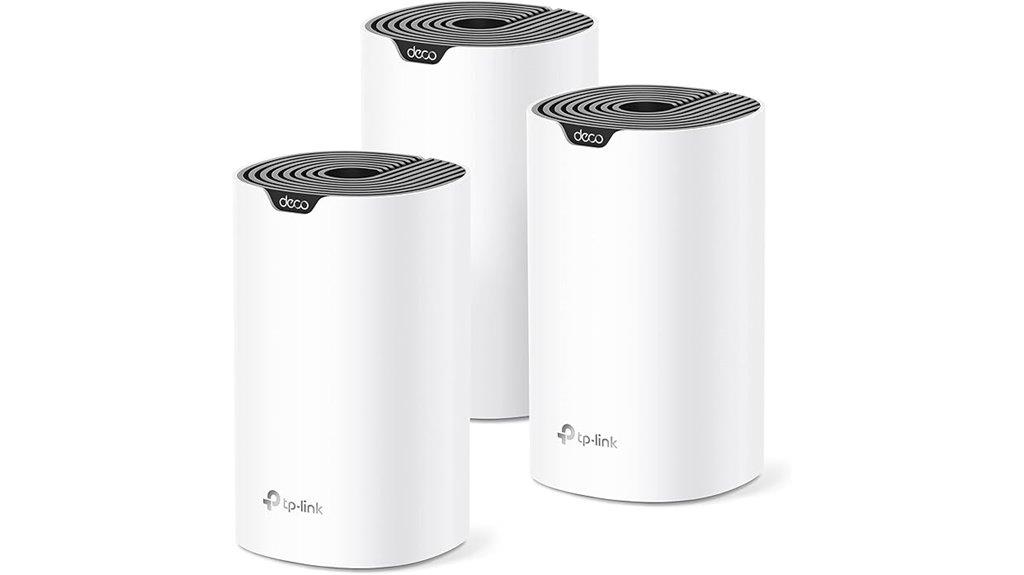
The TP-Link Deco S4 Mesh AC1900 WiFi System is an excellent choice for large households that need reliable, seamless coverage across multiple floors. It covers up to 5,500 sq.ft., replacing routers and extenders, with Deco Mesh technology for fast, stable WiFi in every corner. Supporting up to 100 devices with AC1900 speeds, it ensures high performance throughout your home. Setup is simple via the Deco app, and wired Ethernet backhaul enhances speeds further. Compatible with all major ISPs, it offers easy management, guest WiFi, and voice control options. Users praise its reliable coverage and straightforward installation, making it ideal for busy, multi-story homes.
Best For: households requiring extensive, reliable WiFi coverage across multiple floors and numerous devices without complicated setup.
Pros:
- Seamless coverage up to 5,500 sq.ft. with mesh technology, eliminating dead zones.
- Supports up to 100 devices with high AC1900 speeds for fast, stable internet.
- Easy setup and management via the Deco app, compatible with all major ISPs.
Cons:
- Occasional errors when checking for firmware updates via the app.
- Limited advanced features and customization options for tech-savvy users.
- Requires a modem for most ISP services, and proper setup with existing equipment can be tricky.
Amazon eero Max 7 Mesh WiFi System (3-Pack)
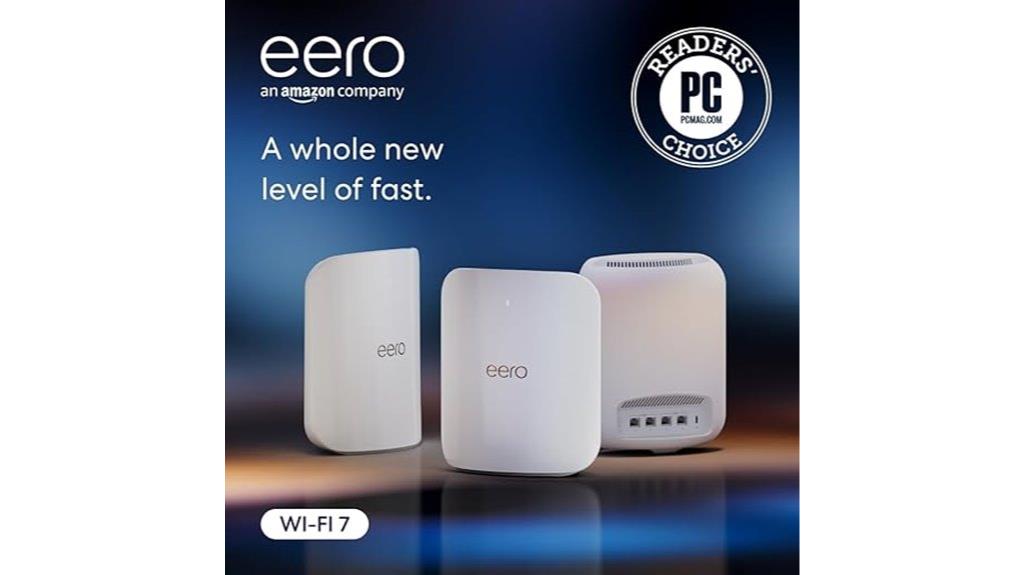
If you’re looking to upgrade your home Wi-Fi with lightning-fast speeds and extensive coverage, the Amazon eero Max 7 Mesh WiFi System (3-Pack) is an excellent choice. It supports internet plans up to 10 Gbps and covers up to 7,500 square feet, connecting over 750 devices seamlessly. With Wi-Fi 7 technology, it offers wireless speeds up to 4.3 Gbps and wired speeds up to 9.4 Gbps through two 10 Gigabit Ethernet ports. The system’s TrueMesh software, along with TrueRoam and TrueChannel, ensures reliable, low-latency connections ideal for gaming, streaming, and smart home devices. Plus, it functions as a smart home hub with enhanced security options.
Best For: households requiring extensive Wi-Fi coverage, high-speed internet, and seamless connectivity for numerous devices and smart home applications.
Pros:
- Supports internet plans up to 10 Gbps with coverage up to 7,500 sq. ft.
- Delivers fast wireless speeds up to 4.3 Gbps and wired speeds up to 9.4 Gbps via two Ethernet ports.
- Features advanced TrueMesh, TrueRoam, and TrueChannel technology for reliable, low-latency connections.
Cons:
- Premium price point may be costly for some users.
- Requires a subscription to eero Plus for advanced security features.
- Setup and optimization might be complex for users unfamiliar with mesh networking systems.
Amazon eero 6 Mesh Wi-Fi System (3-Pack)
https://m.media-amazon.com/images/I/51cpzkQlBiL._SX522_.jpg
Looking to eliminate dead spots and enjoy seamless Wi-Fi coverage across a large home? The Amazon eero 6 Mesh Wi-Fi System (3-Pack) is a solid choice. It covers up to 4,500 sq ft., supporting internet plans up to 500 Mbps with Wi-Fi 6 speeds. Thanks to its ability to handle over 75 devices simultaneously, you’ll experience fast, reliable connections for streaming, gaming, and video calls. Setup is quick via the eero app, and the system doubles as a Zigbee smart home hub. Plus, it’s expandable and automatically updates for security and performance, making it a versatile and future-proof solution for busy households.
Best For: households seeking reliable, high-speed Wi-Fi coverage across large or multi-room homes with smart home integration needs.
Pros:
- Covers up to 4,500 sq ft. with seamless Wi-Fi 6 speeds supporting over 75 devices simultaneously
- Easy setup via the eero app with remote management and automatic updates for security and performance
- Functions as a Zigbee smart home hub, simplifying smart device control and integration
Cons:
- Supports internet plans only up to 500 Mbps, which may be limiting for ultra-high-speed requirements
- Requires a compatible internet service provider and modem, which may add to total setup costs
- Some advanced features or customization options may be limited compared to more complex networking systems
TP-Link Deco XE75 Pro AXE5400 Mesh System (2-Pack)
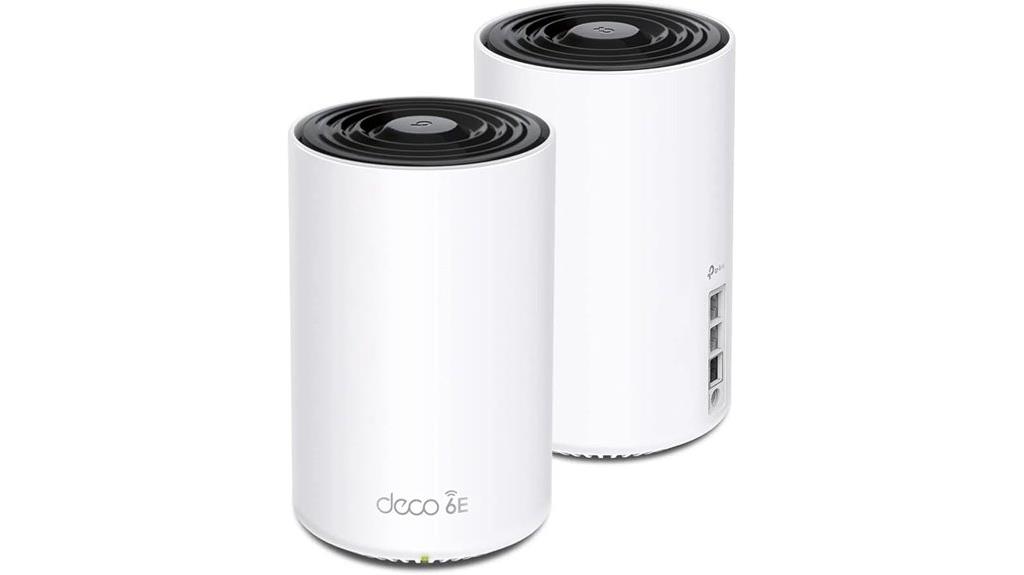
For anyone needing reliable, high-speed WiFi coverage across a large home or property, the TP-Link Deco XE75 Pro AXE5400 Mesh System offers an impressive solution. This tri-band WiFi 6E system covers up to 5,500 square feet with just two units, easily replacing traditional routers and extenders. It features a 2.5 Gbps WAN/LAN port, perfect for gigabit-plus internet plans from major ISPs like Comcast or Verizon. Designed for demanding activities such as streaming 8K content or gaming with AR/VR, it supports up to 200 devices with seamless, stable connections. Setup is simple via the Deco app, and the system provides smart management, security, and reliable performance throughout your home.
Best For: large households or properties requiring high-speed, reliable WiFi coverage for multiple demanding devices and activities such as streaming, gaming, and smart home applications.
Pros:
- Seamless coverage up to 5,500 sq.ft. with just two units, ideal for large spaces
- Supports WiFi 6E tri-band technology with speeds up to 5,400 Mbps and multi-Gig ports for future-proof internet plans
- Easy setup through the Deco app with smart management features and security, including Alexa compatibility
Cons:
- No web-based management interface; setup and control are primarily through the mobile app
- Requires a compatible modem and may need additional configuration with certain ISPs
- Slightly higher price point compared to traditional routers or less advanced mesh systems
NETGEAR Orbi 770 Series Tri-Band WiFi 7 Mesh System
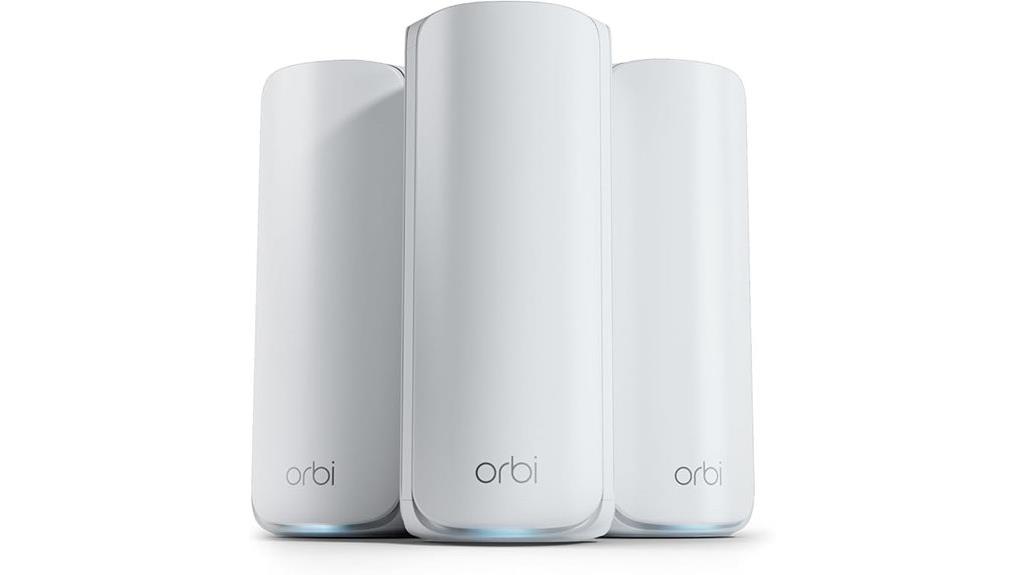
The NETGEAR Orbi 770 Series Tri-Band WiFi 7 Mesh System is an excellent choice for large homes or environments with many connected devices, thanks to its impressive speeds of up to 11Gbps and coverage of up to 8,000 square feet. Its tri-band technology with Enhanced Backhaul maintains consistent speeds across all devices, supporting seamless entertainment, work, and smart home connections. The system includes a router and two satellite extenders, with high-performance antennas and a sleek design for reliable coverage everywhere—from the front door to the backyard. Easy setup, robust security, and wired options make it a top-tier, user-friendly mesh solution.
Best For: households or large properties needing high-speed, reliable WiFi coverage for multiple devices, entertainment, remote work, and smart home integration.
Pros:
- Supports speeds up to 11Gbps with extensive coverage up to 8,000 sq. ft.
- Seamless tri-band WiFi 7 with Enhanced Backhaul for consistent device performance.
- Easy setup via the Orbi app with robust security features and wired connectivity options.
Cons:
- Lacks support for Wireguard VPN, only offering OpenVPN.
- Satellite setup may require firmware updates and manual configuration.
- Slightly higher cost compared to some competitors with similar features.
Google Wifi Mesh WiFi System (3 Pack)
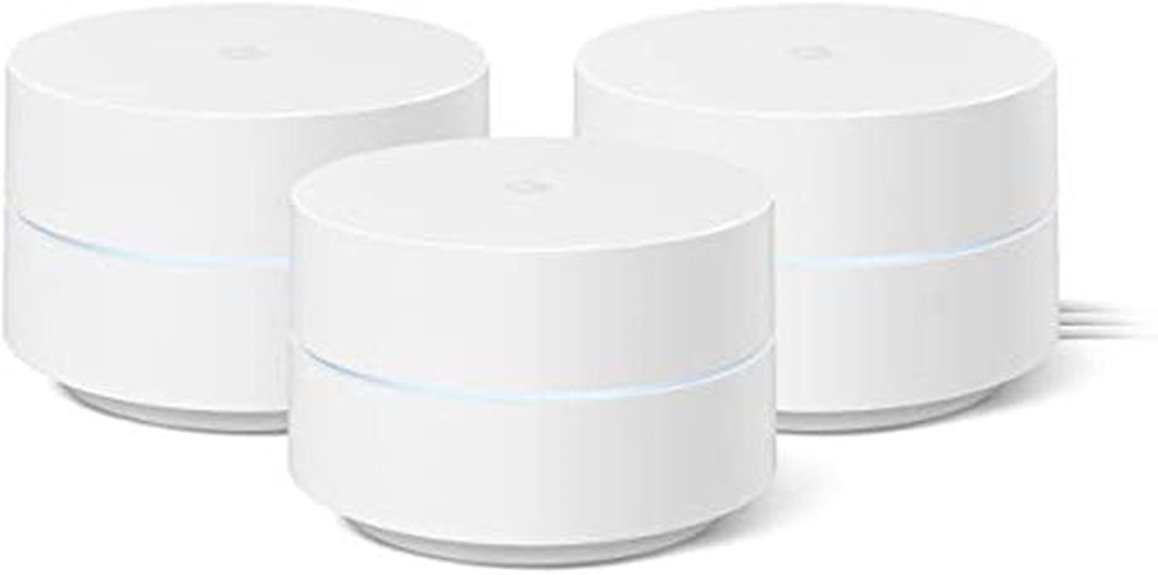
If you have a large or multi-story home struggling with dead zones and inconsistent WiFi, the Google Wifi Mesh WiFi System (3 Pack) offers a reliable solution. Covering up to 4,500 sq ft, these units replace traditional routers and create a seamless mesh network that eliminates dead spots. Setup is quick via the Google Home app, and the system automatically manages bands for ideal speed. Users report improved speeds, stable connections, and smooth streaming—even at outdoor distances up to 60 feet. It’s a dependable, scalable system perfect for homes with multiple floors, thick walls, or high device demands, making your WiFi more reliable and effortless.
Best For: households with large, multi-story homes or thick walls that need reliable, seamless WiFi coverage across multiple rooms and outdoor areas.
Pros:
- Easy setup through the Google Home app with automatic band management for optimal speeds
- Reliable, stable connections with coverage up to 4,500 sq ft, including challenging basement areas
- Supports multiple devices simultaneously, ideal for streaming, gaming, and smart home integration
Cons:
- Some users experience difficulties with QR code scanning and device recognition during setup
- Occasional glitches requiring troubleshooting or app resets reported by a few users
- Larger homes may require additional units beyond the 3-pack for complete coverage
TP-Link Deco WiFi 6 Mesh System (Deco X20)

The TP-Link Deco WiFi 6 Mesh System (Deco X20) stands out as an ideal solution for households needing extensive coverage and reliable performance to support multiple devices. Covering up to 5800 sq ft with three units, it uses Wi-Fi 6 AX1800 technology for fast, stable connections. It supports up to 150 devices simultaneously and includes wired backhaul options for even better speeds. Setup is simple via the Deco app, and the system offers seamless roaming with devices automatically connecting to the strongest unit. While it excels in coverage and capacity, some users find pairing IoT devices tricky, and it lacks a web management interface. Overall, a solid choice for modern smart homes.
Best For: households seeking extensive Wi-Fi coverage, high device capacity, and reliable performance for streaming, gaming, and smart home devices.
Pros:
- Covers up to 5800 sq ft with seamless high-performance Wi-Fi 6 AX1800 technology
- Supports up to 150 devices without performance degradation
- Easy setup and management via the intuitive Deco app, with automatic seamless roaming
Cons:
- Difficulties pairing certain IoT devices due to band and SSID limitations
- Lacks a web-based management interface for advanced network control
- Limited channel flexibility because the system occupies two channels, which may cause interference
Amazon eero Pro 6E Mesh WiFi System (2-Pack)
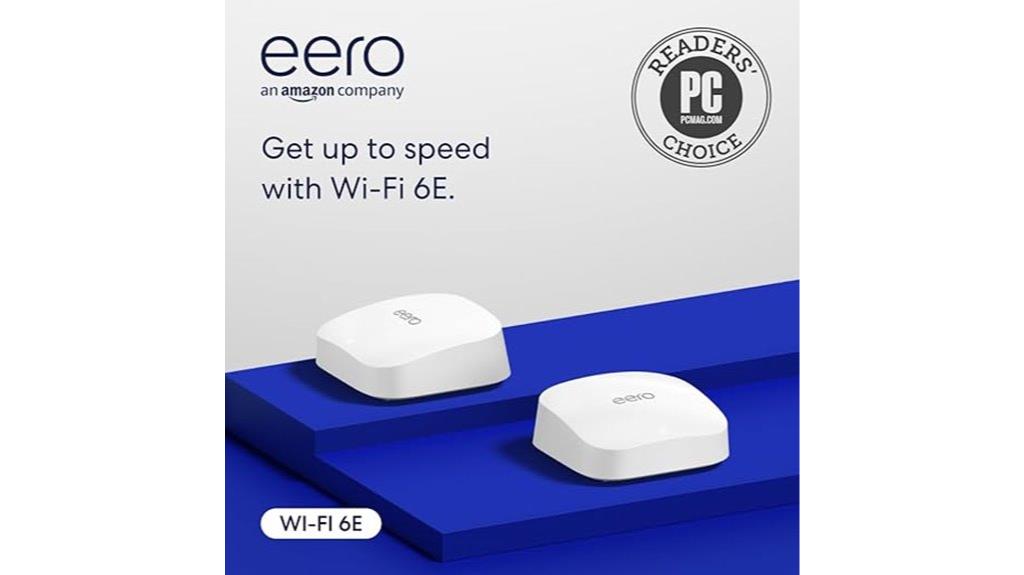
Looking for a mesh Wi-Fi system that can handle gigabit internet plans and support numerous devices simultaneously? The Amazon eero Pro 6E Mesh Wi-Fi System (2-Pack) is a top choice. It supports internet speeds up to 2.5 Gbps and covers 4,000 sq. ft., connecting over 100 devices effortlessly. As the first Wi-Fi 6E eero system, it uses the 6 GHz band for faster speeds and lower latency, even for non Wi-Fi 6E devices. Setup is quick with the eero app, and its TrueMesh technology guarantees reliable, stable connections across your home. It’s a solid option for seamless, high-performance connectivity.
Best For: households or small to medium-sized homes seeking high-speed, reliable Wi-Fi coverage for multiple devices and gigabit internet plans.
Pros:
- Supports internet speeds up to 2.5 Gbps and connects over 100 devices seamlessly
- Uses Wi-Fi 6E with the 6 GHz band for faster speeds and lower latency
- Easy setup and management through the user-friendly eero app with automatic updates
Cons:
- Range can drop faster at the edges compared to some competitors like Orbi
- Slightly less coverage per unit than some other mesh systems, requiring more units for larger areas
- Higher price point relative to some traditional Wi-Fi 5 systems
TP-Link Deco XE70 Pro AXE4900 Mesh WiFi System (3-Pack)
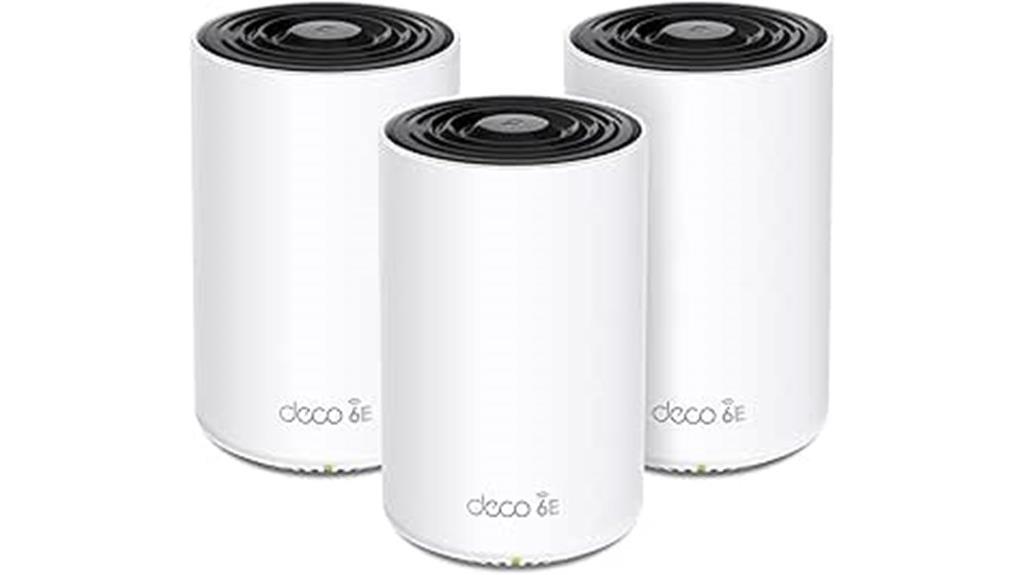
For large homes with multiple devices, the TP-Link Deco XE70 Pro AXE4900 Mesh WiFi System (3-Pack) stands out as an ideal solution thanks to its extensive coverage of up to 7,200 square feet and support for connecting up to 200 devices simultaneously. It uses Wi-Fi 6E technology, including a congestion-free 6 GHz band for faster speeds and reduced interference. With tri-band speeds up to 4.9 Gbps, seamless roaming, and no dead zones, it delivers reliable coverage across multi-story homes. The system also offers advanced wired options, including 10 Gbps ports and 2.5 Gbps Ethernet ports, making it perfect for demanding smart homes.
Best For: households with large, multi-story homes that require extensive Wi-Fi coverage and support for numerous connected devices.
Pros:
- Extensive coverage up to 7,200 sq. ft. with three units, ideal for large homes
- Supports up to 200 devices simultaneously for seamless smart home connectivity
- Advanced wired options with 10 Gbps and 2.5 Gbps Ethernet ports for high-speed wired connections
Cons:
- Web interface is limited, with most management done through the Deco app
- Higher price point around $1,000 for the 3-pack, which may be costly for some users
- Client device support for Wi-Fi 7 is limited, so full benefits may not be realized immediately
NETGEAR Orbi Whole Home WiFi 6 Mesh System
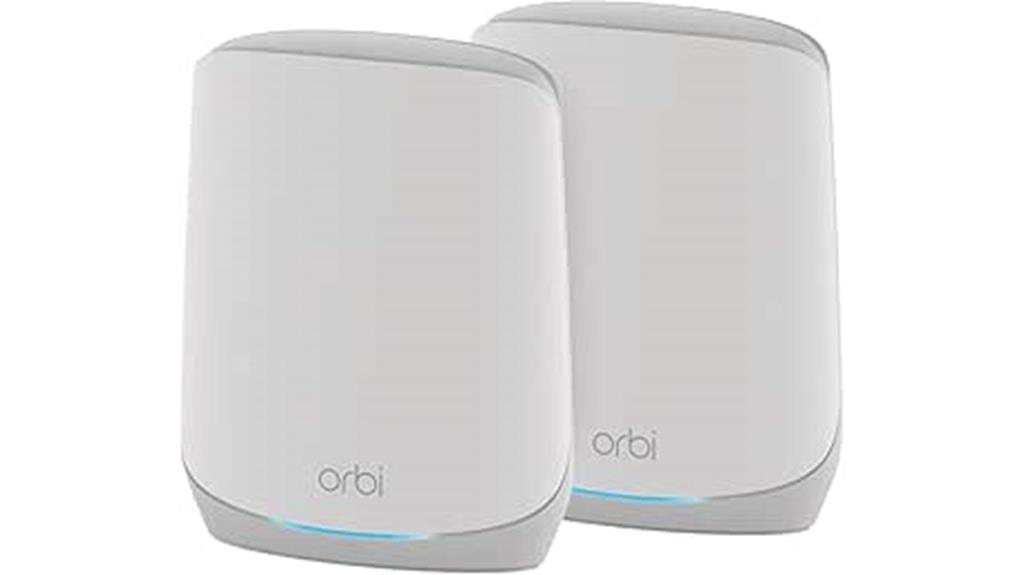
If you’re seeking a reliable WiFi solution that covers large homes and supports multiple devices, the NETGEAR Orbi Whole Home WiFi 6 Mesh System stands out. It offers up to 5,000 sq. ft. of coverage and supports 75 devices simultaneously with AX5200 gigabit speeds. The system includes a router and satellite extender, easy setup via the Orbi app or website, and advanced security features like NETGEAR Armor. Customers praise its strong, consistent coverage and fast speeds, though some encounter setup challenges or connection drops. Overall, it’s an effective choice for large households needing seamless, high-performance WiFi.
Best For: households seeking extensive WiFi coverage and reliable high-speed connectivity across large, multi-story homes with many devices.
Pros:
- Provides up to 5,000 sq. ft. coverage supporting 75 devices simultaneously
- Easy setup via the Orbi app or website with quick, straightforward installation
- Advanced security features with NETGEAR Armor for protection against cyber threats
Cons:
- Some users experience setup difficulties or require manual configuration
- Occasional connection drops or slower speeds if not properly configured
- Limited support in languages outside the U.S., affecting usability in other regions
Google Nest WiFi Pro 3 Pack Mesh Router

The Google Nest WiFi Pro 3 Pack Mesh Router stands out for households seeking ultra-fast, reliable Wi-Fi coverage across large indoor spaces. It leverages Wi-Fi 6E technology, supporting speeds up to twice as fast as Wi-Fi 6 and access to the new 6 GHz band, ideal for compatible devices. Covering roughly 6,600 square feet with three units, it’s perfect for big homes, though thick walls may require extra nodes. Setup is straightforward via the Google Home app, and the system adapts automatically to network needs. While it offers strong signals and stable connections, its Ethernet speed is limited to 1 Gbps, and software stability can sometimes be a challenge.
Best For: households with large indoor spaces seeking ultra-fast, reliable Wi-Fi coverage and compatible Wi-Fi 6E devices.
Pros:
- Supports Wi-Fi 6E with access to the new 6 GHz band for faster speeds and less interference
- Covers up to 6,600 sq. ft. with three units, ideal for large homes
- Easy setup via the Google Home app with automatic device recognition
Cons:
- Ethernet speed limited to 1 Gbps, which may be insufficient for some high-bandwidth needs
- Software stability and setup can be fragile and sometimes complex
- No outdoor coverage or support for outdoor deployment
Factors to Consider When Choosing Mesh Wi‑Fi Systems
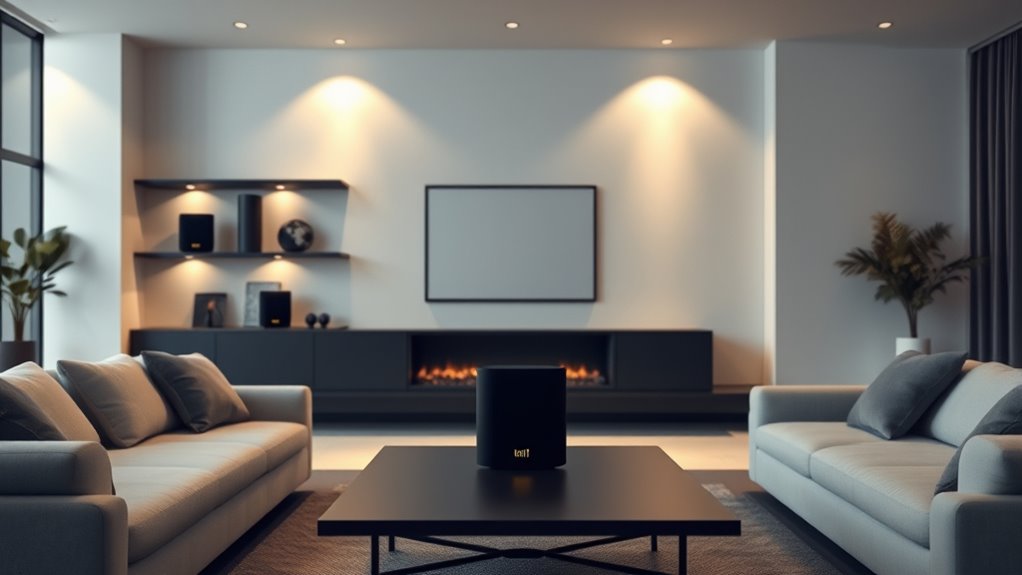
When choosing a mesh Wi‑Fi system, I consider factors like coverage area to guarantee it fits my home’s size and layout. I also check device compatibility and whether I need wired or wireless backhaul for peak performance. Security features and ease of setup are equally important to me for a seamless and safe experience.
Coverage Area Needs
Determining the right coverage area for your mesh Wi-Fi system starts with evaluating your home’s size and layout. I recommend measuring the total square footage to understand the minimum coverage needed. Keep in mind that multiple floors and thick walls can block signals, reducing coverage. It’s helpful to identify spots with weak or no Wi-Fi to ensure the system eliminates dead zones. For larger homes over 5,000 square feet, you might need more nodes or a higher-capacity system to keep Wi-Fi reliable everywhere. Don’t forget outdoor spaces and garages—these areas may require extra outdoor-friendly nodes or extenders. By examining these factors, you can select a mesh system that provides seamless, strong coverage tailored to your home’s unique structure.
Device Compatibility
Have you checked if your chosen mesh Wi-Fi system supports the Wi-Fi standards, like Wi-Fi 6 or Wi-Fi 6E, that your devices use? Ensuring compatibility with these standards is essential for peak performance and future-proofing. You should also verify that the system can connect seamlessly to your existing modem and meets your ISP’s requirements, whether it’s Ethernet or fiber. Additionally, consider if it supports various device types, such as smart home gadgets, gaming consoles, and IoT devices, for smooth integration. Look for features like device-specific settings, separate SSIDs, or band steering, which help enhance performance for different devices. Lastly, check if the system supports advanced security protocols like WPA3 to keep your network secure and manageable.
Wired Vs Wireless Backhaul
Choosing the right backhaul method substantially impacts your mesh Wi-Fi system’s performance. Wired backhaul uses Ethernet cables to connect nodes, offering a stable, high-speed link that minimizes interference and latency, especially over longer distances. This setup ensures consistent speeds and low latency, making it perfect for gaming and 4K streaming. It also frees up Wi-Fi bands, reducing congestion and improving overall network efficiency. On the other hand, wireless backhaul relies on Wi-Fi signals, which can be affected by walls, interference, and distance, potentially degrading performance. While wireless setups offer easier installation and flexibility, they depend heavily on signal strength and line of sight. Ultimately, wired backhaul provides more reliability, but wireless backhaul may suit those who prioritize simplicity and flexible placement.
Security Features
When selecting a mesh Wi-Fi system, security features are a crucial factor to take into account because they protect your network from cyber threats and unauthorized access. Look for systems that offer advanced encryption like WPA3, which provides stronger security than previous standards. VPN support and automatic firmware updates are essential for patching vulnerabilities promptly. Some systems include built-in cybersecurity tools or subscriptions that detect threats in real time and offer parental controls. Network segmentation features, such as guest networks and device isolation, help limit access to sensitive devices. Regular security patches are essential to stay ahead of emerging threats. Supporting security standards like the U.S. Cybersecurity and Infrastructure Security Agency’s Secure-by-Design pledge shows a focus on trustworthy, robust security practices that safeguard your home network effectively.
Ease of Setup
Security features are vital when selecting a mesh Wi-Fi system, but ease of setup can make a significant difference in how smoothly your network gets up and running. Most systems now use mobile apps that guide you step-by-step through the setup process, often taking just minutes. Many support barcode scanning or QR codes on nodes, simplifying pairing and identification. Proper placement of the primary node and satellites is essential, and many models include visual or app-guided instructions to help optimize locations for better coverage. If available, wired backhaul options can also ease setup and improve stability by reducing wireless interference. Overall, user-friendly systems focus on intuitive interfaces and minimal configuration, making setup accessible even for non-technical users.
Future-Proof Technology
To guarantee your mesh Wi-Fi system remains effective as technology advances, it’s essential to choose models that support the latest standards like Wi-Fi 6E and Wi-Fi 7. These assure compatibility with upcoming devices and new applications. Look for systems with multi-gigabit wired ports, such as 2.5 Gbps or 10 Gbps Ethernet, which seamlessly match high-speed internet plans, especially fiber connections. Advanced features like Multi-Link Operation (MLO), OFDMA, and TWT in Wi-Fi 7 boost capacity, reduce latency, and optimize network efficiency for future demands. Compatibility with emerging smart home protocols like Thread, Matter, and Zigbee guarantees ongoing device interoperability. Additionally, firmware updates and scalable hardware design help your system adapt to evolving technology and maintain long-term performance.
Frequently Asked Questions
How Does Mesh Wi-Fi Improve Coverage in Large or Multi-Story Homes?
Mesh Wi-Fi improves coverage in large or multi-story homes by using multiple interconnected nodes that work together to create a single, seamless network. I’ve noticed that it eliminates dead zones, providing strong, consistent signals everywhere, even upstairs or in the basement. Instead of a single router struggling to reach all corners, the mesh system intelligently routes data through the best path, ensuring fast, reliable internet throughout my entire home.
Can Mesh Wi-Fi Systems Prioritize Bandwidth for Specific Devices?
Think of a mesh Wi-Fi system as a traffic cop directing data where it’s needed most. Yes, many mesh systems let you prioritize bandwidth for specific devices, ensuring your streaming or gaming gets the attention it deserves. I’ve found this feature helpful when balancing work and entertainment, making sure your important devices stay smooth and responsive, even when others are hogging the network.
Are Mesh Systems Compatible With All Internet Service Providers?
I get asked if mesh systems work with all internet providers, and I want to reassure you. Most mesh Wi-Fi systems are compatible with a wide range of ISPs, including cable, fiber, and DSL services. However, it’s always wise to double-check the specific system’s requirements and your provider’s setup. I recommend confirming compatibility beforehand to guarantee smooth installation and peak performance.
How Secure Are Mesh Wi-Fi Networks Against Cyber Threats?
Oh, the irony is rich—our shiny new mesh Wi-Fi networks, supposedly the pinnacle of security, often face cyber threats just like traditional setups. I’d say they’re pretty secure if you keep firmware updated and use strong passwords. But, of course, no system is invincible. So, I stay vigilant, use encryption, and trust that, with proper care, my network stays safer from cyber threats than I’d like to admit.
What Is the Typical Lifespan and Upgrade Cycle for Mesh Wi-Fi Hardware?
You’re wondering about the lifespan and upgrade cycle for mesh Wi-Fi hardware. Typically, I find that these systems last around 3 to 5 years before performance starts to decline or new features emerge. I recommend upgrading sooner if you notice slower speeds or connectivity issues. Staying updated guarantees you get the latest security and performance improvements, so I usually plan to replace or upgrade my mesh system every few years.
Conclusion
So, after all this talk about blazing speeds and endless coverage, I guess it’s clear that choosing the right mesh Wi-Fi system isn’t rocket science—it’s just smarter home tech. Sure, with these options, your Wi-Fi might finally outsmart your streaming habits (or at least keep up). But don’t worry if it feels overwhelming; even the best systems are only as good as the Wi-Fi habits you bring to the party. Happy surfing!

